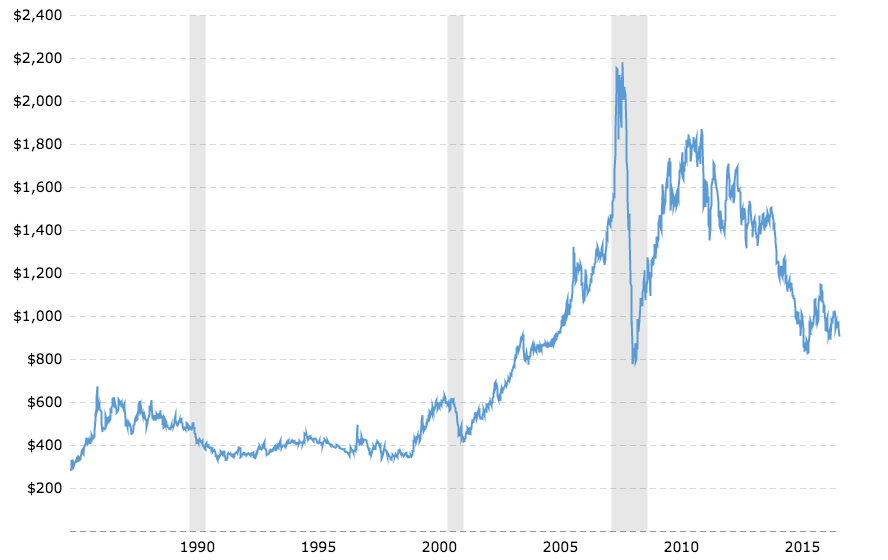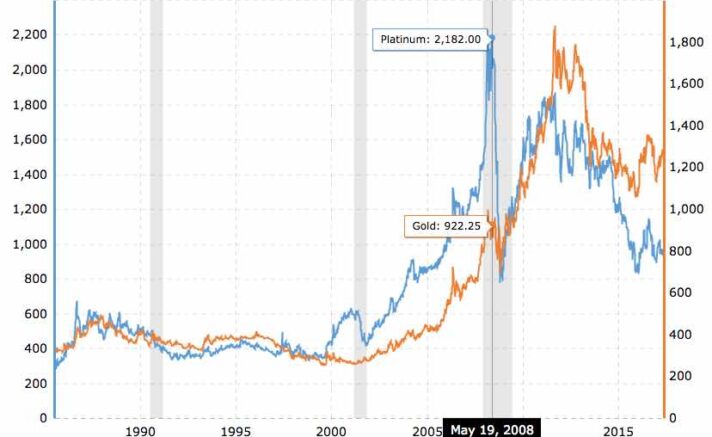Investing in Platinum Quality Returns
Today’s information is what you’d find in a paid service. But, as you know, I give pretty much everything away for free. The REALLY valuable stuff requires physical action… like traveling to Colombia for our upcoming investment trip in June, which is unfortunately sold out.
I’ll keep giving away free ideas (like you’re about to read), but if you want to get in on the ‘big stuff’ keep your eye out for the next trip…
When I see an asset class that is trading for multi-year lows, my ears perk up.
For most people, investing in an asset that is at rock bottom seems scary. But, if you think about it, that is exactly when you want to invest.
Would you rather invest in something at its highs (with lots of downside risk), or invest when something is at its lows (with massive upside potential)?
The answer is easy for me:
I want to invest in things with minimum downside risk and massive upside potential.
That seems simple in concept, but surprisingly few investors execute this strategy. That’s because it’s hard to invest in something that has seen so much pain for so long.
However, if we use data and look at historical trends, we can set ourselves up to enter near the bottom of a trend as opposed to at the top.
It’s nearly impossible to time these investments perfectly. But, when you are investing at the bottom, you don’t have to time it perfectly. The gains you will make over the longer term will more than make up for any small losses you have in the beginning.
With that said… let me show you an investment that has had a horrible past couple of years.
And let me show you a way where you can profit no matter what. If you get the trade right you’ll make a lot of money… and if you get the trade wrong you’ll still make money!
You’re more likely to have this metal on your finger than in your investment portfolio.
Platinum is a rare earth metal that most investors don’t understand… and that is where our opportunity is…
For every ten ounces of gold mined every year, there is less than one ounce of platinum. This is due both to demand and supply. Most experts agree that the platinum supply on earth is 30-to-1 compared to gold.
Platinum truly is a rare and precious metal.
But, right now, platinum is selling for less than gold. A lot less.
Think about that. Platinum hasn’t been this cheap compared to gold for this long in over 100 years.
Source: Macro Trends
Platinum (the blue line) can have explosive upward movements, as seen in 2008 where it outpaced the price of gold by more than double.
This is not normal both in supply economics and in historical pricing trends. Or in other words, platinum is due for a huge price swing.
But saying something is “due for a change” is not enough. Things can be due for change for a long time, which can leave investors waiting (and missing out on other opportunities) until that change happens.
We have to be careful to not get too invested (monetarily and emotionally) in the idea that platinum will all of a sudden rocket higher.
But… could the price of platinum really “rocket” higher?
First, let’s take a look at some of the reasons why platinum is abnormally undervalued right now…
When determining the value of anything you must be able to compare it to something else.
For example, if there was a house for sale for $1 million dollars, you wouldn’t know if it was expensive or cheap in price terms. The actual value of the home would depend on its location, size, build quality, and a whole bunch of other factors.
So, if we’re looking at the price of platinum, we’d have to find something to compare. We can look at the gold-to-platinum ratio, which really determines how many ounces of platinum it takes to buy one ounce of gold.
Source: DG
As we can see from the chart above, the average ratio is 0.8. That means on average it takes 0.8 ounces of platinum to buy one ounce of gold.
However, right now (May of 2017) this ratio is nearly off the chart.
Well, at least this chart.
It currently takes 1.35 ounces of platinum to buy one ounce of gold.
Now, remember how I told you that platinum is more rare than gold? And remember how there is more gold production than platinum? This means that platinum should be priced much higher than gold.
But, it’s not. It’s actually priced much lower. And historically speaking, this is not normal.
Stick with me here… I’m about to get a little technical, but this is an important concept to understand:
If we use the theory of “mean reversion,” then it’s somewhat safe to say that this ratio will at some point return to the average.
(“Mean reversion” is the theory suggesting that prices and returns eventually move back toward the mean or average. This mean or average can be the historical average of the price or return, or another relevant average such as the growth in the economy or the average return of an industry.)
Furthermore, when a ratio gets significantly out of whack, then it normally returns in the opposite direction with similar distortion.
This can be seen in the 2008 ratio of gold-to-platinum versus what is happening right now. If you look at the above chart again, you can see the massive price swing that happens from 2008 into 2009. The price swing back the other way may occur now that the ratio is in the polar opposite.
Another simple way to think about this is to go back to the housing crash in the US. Because home prices went sky high, the resulting crash was that more devastating. That’s because the swing down has the same amplitude as the swing up (it’s just that the swing down happened a lot faster, as most crashes do!).
In addition to platinum being cheap compared to gold, platinum miners are starting to shut down operations.
Investors understand the boom and bust cycles that the mining industry experiences, and know that once the bust starts to happen, it’s only a matter of time until the industry starts to bottom.
Furthermore, 80% of the worlds platinum is produced in South Africa, which has been going through a tumultuous time… and unfortunately for the country, things may get worse before they get better.
This tension in South Africa may further drive down the production of platinum, which will inturn further depleat world supplies.
Where does the platinum supply go to anyway?
Glad you asked…
Platinum is used in the automotive industry (~40%), industrial use (~20%), jewelry (~35%), and for investment (~5%).
Platinum is overwhelmingly used in catalytic converters in the auto industry. And while we hear news all day about electric cars and flying taxis, here is the reality: Most people are buying diesel and gas powered vehicles.
On top of that, countries around the world are cracking down on their emmissions.
*Cough* China is leading the way in that area.
With that in mind…
“Platinum Quarterly [today] raised the predicted platinum market deficit for 2017 to 120 koz for the year. The upward revision comes after confirmation that the market ended 2016 270 koz in deficit, a deeper shortfall than previously estimated.”
Additionally…
“2017 will be the sixth consecutive year that global platinum consumption has outstripped supply, with total supply, from mining and recycling, this year predicted to fall by 4 per cent compared to 2016.”
And…
“There was a marked increase in the buying of platinum Exchange Traded Funds (ETFs) in the final quarter of 2016, which saw net buying 200 koz higher than in the previous quarter.”
All info from the World Platinum Investment Council
Finally, take a look at this historical platinum price chart:

Source: Macro Trends
See those dark areas? Those are US recessions. The price of platinum has plummeted the last two times. That’s because of platinum’s correlation to the auto industry and industrial market. When the economy tanks, so does the consumption.
But… see what happens before and after that time? The price goes up.
So where are we in May of 2017?
Well… we’ll only know for sure several years from now.
However, here is what we do know:
The economy has been in a bull market for an abnormally long period of time and stocks are expensive by a variety of measures. A crash could happen any day.
OR
The economy hasn’t truly experienced a frenzy, like the last two times the market peaked. Furthermore, many investors are feeling cautious which implies that not enough of the market is piled in yet to create a crash.
If a market crash happens tomorrow, then the price of platinum will probably be negatively impacted. However, because it’s already inexpensive and because it hasn’t really seen a positive rally in many years, the downside is probably limited.
If the market doesn’t crash tomorrow (or for the next year or more), then we could start to see the price of platinum skyrocket. A double in price is not out of the question at all.
Either way, we are looking at minimum downside risk and massive upside potential.
Sounds familiar, right?
However, like I mentioned at the beginning, just because platinum looks like it will turn around doesn’t mean it will happen tomorrow.
So what do we do until then?
We can wait patiently until we start to see a solid turnaround, which I will definitely stay on top of and let you know when I think we’re seeing a change… or…
We can sell put options.
(If you are already an options pro, take a look at the current platinum companies (there are very few), so you can identify a few that are candidates.)
Do not do not actually do this if you are unfamiliar with options. Take this as more of an educational lesson, which you can implement once you are completely familiar with how to trade options. Check out this resource here to fully understand selling puts.
Of course, the key is to know which companies to trade. I’ll be following up with that information as this market develops…




